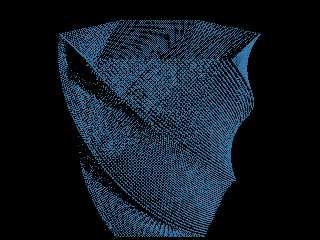|
 |
I've been working on an object for a WIP, and I originally wanted to model it as
an isosurface. I have thought of two different ways of describing the surface
unfortunately, one is far from precise and the other doesn't seem to translate
well when I make the calculations into functions.
#version 3.7;
#include "math.inc"
#default {
pigment { rgb <0.07,0.37,0.75> }
finish { ambient 0 }
}
#local N = 6;
#local R0 = 2;
#local S = 2 * pow( sin(pi/(2*N)), 2 );
#local A = R0 - S;
#local r = 360 / P;
#local l = 90 - r/2;
#local dS = 0.0625; // S = RT --> T = S/R tf. dT = dS/R
#for(H,-2,2,0.03125)
#for(T,0,360,1)
#local p1 = R0 * sind(l + mod(T, r));
#local p2 = p1 - A;
#local R1 = R0 - p2/sind(l + mod(T, r));
// I'm still trying to get a handle on the twist period.
#local p3 = vrotate(<R1,H,0>, (T + H*degrees((2*pi/12)))*y));
sphere { p3 0.015625 }
#end
#end
I've attached an image below.
I've tried saving the points as a point cloud in stanford .ply format and
importing that into MeshLab where I can calculate the Delaunay Triangulation
and vertex normals. It looks good in meshlab, but when I export it as an .obj
and import it into blender it looks all bulbous, like the normals are flipped.
I have no experience with mesh work, and I could use any suggestions.
Regards,
A.D.B.
Post a reply to this message
Attachments:
Download 'workshop4.png' (667 KB)
Preview of image 'workshop4.png'

|
 |




![]()